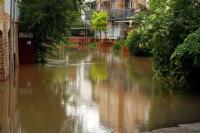-
Flood-related losses in Germany to increase under climate change

Flood-related losses can be expected to increase considerably in Germany as a result of climate change, a new study shows. Extreme events like the severe floods along the river Elbe have already illustrated the potentially devastating consequences of certain weather conditions such as severe rainfall events, when continuing intense rain can no longer be absorbed by the soil and water levels in the rivers rise. Without appropriate adaptation, flood-related damage of currently about €500 million a year could multiply in the future, according to the comprehensive expert analysis.
-
-
Studying the basic science of nuclear waste
Approximately 300 million liters of highly radioactive wastes are stored in hundreds of underground tanks at the Hanford Site in Washington and the Savannah River Site in South Carolina. These wastes are extremely complicated mixtures of salts and sludges that have been exposed to ionizing radiation for decades. Their chemistry is dominated by interactions at solid-liquid interfaces that are poorly understood. A more thorough understanding of the chemistry of radioactive waste is key to treating this unwanted byproduct of winning the Second World War and the cold war.
-
-
Cities face dramatic increase in water treatment spending when watersheds are damaged
A new global study has found that one in three large cities spend 50 percent more on water treatment costs as a result of damage to the ecological quality of their watersheds. This study found that urban source watershed degradation is widespread globally, with 9 in 10 cities losing significant amounts of natural land cover to agriculture and development in the watersheds that supply their drinking water. This has led to polluted water and an increase in water treatment costs that represent a liability in excess of $100 billion.
-
-
New research predicts a doubling of coastal erosion by mid-century in Hawai’i
Chronic erosion dominates the sandy beaches of Hawai’i, causing beach loss as it damages homes, infrastructure, and critical habitat. Researchers have long understood that global sea level rise will affect the rate of coastal erosion. Newresearch team developed a simple model to assess future erosion hazards under higher sea levels.
-
-
Cape Cod susceptible to potential effects of sea-level rise
Cape Cod is vulnerable to rising water tables and, in some areas, groundwater inundation as a result of rising sea levels, according to a new U.S. Geological Survey study (USGS). Groundwater inundation occurs when the water table reaches or exceeds land surface. The challenges associated with the issue are likely to become more prevalent as seas rise. Depending on the severity, it may make areas unsuitable for residential and commercial development.
-
-
As nuclear power plants close, states need to bet big on energy storage
Nuclear power plants saw their heyday in the early 1970s and were praised for their ability to produce large amounts of electricity at a constant rate without the use of fossil fuels. We are now observing a trend whereby long-running nuclear power plants are shutting down, and of utilities moving toward renewable electricity generation, such as solar and wind. Can utilities supply electricity around the clock using these alternative generation sources? And crucially, can energy storage technologies provide the power on demand that traditional generators have done? It is clear that energy storage is the major limitation to achieving a carbon-free electricity grid. Careful planning is needed to ensure that energy storage systems are installed to take over the baseline load duties currently held by natural gas and nuclear power, as renewables and energy efficiency may not be able to carry the burden.
-
-
Fukushima and the oceans: What do we know, five years on?
A major international review of the state of the oceans five years after the Fukushima disaster shows that radiation levels are decreasing rapidly except in the harbor area close to the nuclear plant itself where ongoing releases remain a concern. At the same time, the review’s lead author expresses concern at the lack of ongoing support to continue the radiation assessment, which he says is vital to understand how the risks are changing.
-
-
Managing the endangered Rio Grande River across the U.S.-Mexico border

The Rio Grande (called Rio Bravo in Mexico) is the lifeline to an expansive desert in the southwest United States and northern Mexico. From Colorado to the Gulf of Mexico, over 3,000 km, people depend on the river to quench their thirst and irrigate their crops. Yet as the river flows from the United States, it brings with it conflicts and challenges. The water level in the river is declining as use exceeds supply. Water demand is rising as the population in the region grows, and corresponding economic growth drives continued development. Moreover, climate change is expected to lower water levels even further, exacerbating the problems.
-
-
Building indestructible bridges
A design process called “form-finding,” inspired by the natural world, could make possible a new generation of indestructible bridges. Form-finding enables the design of rigid structures that follow a strong natural form — structures which are sustained by a force of pure compression or tension, with no bending stresses, which are the main points of weakness in other structures.
-
-
Increasing power grid cybersecurity

Cybersecurity experts are leading a new program to develop new data analysis methods better to protect the nation’s power grid. The goal of this project is to develop technologies and methodologies to protect the grid from advanced cyber and threats by developing the means to distinguish between power grid failures caused by cyber attacks and failures caused by other means, including natural disasters, “normal” equipment failures, and even physical attacks.
-
-
80% of EU oil imports now supplied by non-European companies
Non-European companies supply four-fifths of Europe’s oil imports, with Russian firms supplying more than one-third (36 percent) of imported crude, a new study on Europe’s foreign oil dependency has found. Just two of the top ten oil suppliers to the EU are European, and most of our imported oil is supplied from unstable countries.
-
-
Coconut shells inspire design ideas for earth-quake proof buildings

Coconuts are renowned for their hard shells, which are vital to ensure their seeds successfully germinate. Coconut palms can grow 30-meter high, meaning that when the ripe fruits fall to the ground their walls have to withstand the impact to stop them from splitting open. The specialized structure of coconut walls could help to design buildings that can withstand earthquakes and other natural disasters.
-
-
Lessons learned from the U.S.-Canada cross-border experiment
A tornado has just devastated a community on the border between the United States and Canada. Paramedics scramble to bring patients from over-crowded hospitals across the border. Communication blackouts and downed trees force ambulances to weave their way through blowing debris, fallen electrical lines, and car wrecks. The time for a routine trip from the injury site to the hospital has now tripled. While this did not really happen, it was the focus in April when the DHS S&T and several Canadian government agencies collaborated on a cross-border experiment with a focus on preparing emergency responders for this type of scenario.
-
-
Colorado county adopts NIST community resilience guidelines
The Boulder County Collaborative, a partnership of Boulder County, Colorado, communities formed in response to the catastrophic floods that struck the region in September 2013, has used the NIST Community Resilience Planning Guide for Buildings and Infrastructure Systems to develop and adopt its own resilience design performance standard for community facilities and infrastructure systems.
-
-
Modeling program helps efficient water management
For as long as civilization has existed, river basins have been the lifeblood of human settlement. And who is to say that ancient Babylon might not have benefited from a watershed management plan? Today there are many more people who rely upon water to a much greater degree, which is why a team of researchers has developed a modeling platform called Water and Energy Scenarios Testing — WEST — for integrated resource planning.
-
- All
- Regional
- Water
- Biometrics
- Borders/Immig
- Business
- Cybersecurity
- Detection
- Disasters
- Government
- Infrastructure
- International
- Public health
- Public Safety
- Communication interoperabillity
- Emergency services
- Emergency medical services
- Fire
- First response
- IEDs
- Law Enforcement
- Law Enforcement Technology
- Military technology
- Nonlethal weapons
- Nuclear weapons
- Personal protection equipment
- Police
- Notification /alert systems
- Situational awareness
- Weapons systems
- Sci-Tech
- Sector Reports
- Surveillance
- Transportation
Advertising & Marketing: advertise@newswirepubs.com
Editorial: editor@newswirepubs.com
General: info@newswirepubs.com
2010-2011 © News Wire Publications, LLC News Wire Publications, LLC
220 Old Country Road | Suite 200 | Mineola | New York | 11501
Permissions and Policies
Editorial: editor@newswirepubs.com
General: info@newswirepubs.com
2010-2011 © News Wire Publications, LLC News Wire Publications, LLC
220 Old Country Road | Suite 200 | Mineola | New York | 11501
Permissions and Policies
